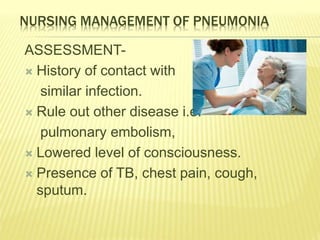Pneumonia
- 1. PNEUMONIA -By Pinky Rathee M.Sc (H) Nursing
- 2. DEFINITION Pneumonia (pneumonitis) is an inflammatory process in lung parenchyma usually associated with a marked increased in interstitial and alveolar fluid.
- 3. ETIOLOGY AND RISK FACTORS MANY CAUSES- bacteria, viruses, mycoplasmas, fungal agents and protozoa. ASPIRATION – of fluid, food, or vomitus, inhalation of toxic or caustic chemicals, smoke, dust, or gases.
- 4. MAJOR RISK FACTORS- Advanced age History of smoking Upper respiratory infection Tracheostomy intubation
- 5. CONT. Immuno -suppressive therapy Non-functional immune system Malnutrition Dehydration Chronic disease states like DM, heart failure, chronic lung disease, cancer,
- 6. ADDITIONAL RISK FACTORS- Exposure to air pollution Altered consciousness (from alcohol, drug overdose, general anesthesia, seizures). Inhalation of noxious substance Aspiration of food, liquid, foreign or gastric materials.
- 8. 1. BASED ON AREA INVOLVEMENT 2. BASED ON CAUSATIVE AGENT BACTERIAL PNEUMONIA AYPICAL OR NON-BACTERIAL PNEUMONIA
- 9. PATHOPHYSIOLOGY Risk factors /Major /Additional risk factors ↓ Inflammatory Pulmonary response to offending organs /agent ↓ Defensive mechanism of lungs lost ↓ Organisms penetrate he sterile lower respiratory tract ↓ Decreased mechanical defences of cough and cilliary motility ↓
- 10. CONT. Colonization of agent in lungs ↓ Infection / inflammation and fluid filled alveolar sacs ↓ Ineffective exchange of CO2 and O2 ↓ Lung exudate with consolidate ↓ Ventilation / perfusion mismatch ↓ PNEUMONIA
- 11. CLINICAL MANIFESTATIONS Fever, chills, sweats- pleuritic chest pain, cough, sputum production, hemoptysis, dyspnea, headache and fatigue. Chest auscultation- Bronchial breath sound over consolidate lung areas, crackling sounds (from fluid in interstitial and alveolar sac).
- 12. CONT. Increased tactile fremitus over areas of pneumonia, where as percussion sounds are dulled. Unequal chest wall expansion during inspiration. Whispered pectoriloquy (transmission of sound whispered words through the chest) heard over affected areas.
- 14. HYPOSTATIC PNEUMONIA Serious illness occurs in bedridden patient as they are deprived of the opportunity to move normally and even turn from side to side causes deterioration in ventilation and sputum accumulation in bronchi occurs which results inflammation develops in the organs causing hypostatic pnemonia.
- 15. SIGN AND SYMPTOM OF HYPOSTATIC PNEUMONIA Shortness of breath and hard breathing. Febrile state, rapid heart rate, coughing with blood. Increased sweating and chills.
- 16. DIAGNOSIS Sputum culture analysis and sesitivity or serologic test. Fibroptic bronchoscopy or transcutaneous needle aspiration cytology. Chest X-ray Additional diagnostic tests- 1. Skin test for TB 2. Blood and uric culture 3. ABG
- 17. MEDICAL MANAGEMENT Broad spectrum Antibiotics (ampicillin, Cefuroxime, augmentin). Respiratory support. Bronchodilator medicine, chest physiotherapy. Fluid and electrolyte management. Symptomatic treatment for fever and to reduce pain by analgesics and antipyretics are given.
- 18. NURSING MANAGEMENT OF PNEUMONIA ASSESSMENT- History of contact with similar infection. Rule out other disease i.e. pulmonary embolism, Lowered level of consciousness. Presence of TB, chest pain, cough, sputum.
- 19. NURSING DIAGNOSIS Ineffective airway clearance related to decrease cough reflex secondary to disease process. Increase fluid intake. Encourage and teach effective coughing and deep breathing exercises. Side lying position Bronchodilating agents Chest physiotherapy, artificial airway.
- 20. CONT. Ineffective breathing pattern related to tachypnea secondary to disease process. Raise head of bed to 45 degree. Teach client how to splint chest. Cough suppressants and analgesic. Monitor ABG, chest auscultation. Incentive spirometry.
- 21. CONT,. Activity intolerance related to decreased oxygen level for metabolic demands secondary to disease process. Reassess for marked dyspnea. Psychological support and quiet environment. Pursed lip breathing. Chest physiotherapy.
- 22. THANK YOU





















